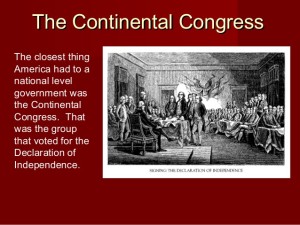Have Radical Federalists Hijacked the Constitution?
 Long before radical federalists toppled America’s first government in 1789, the United States of America was ruled by the Continental Congress, the third phase of which was the Congress of the Confederation. Yes, revolutionary governments tend to be full of idealism and principle—and military power.
Long before radical federalists toppled America’s first government in 1789, the United States of America was ruled by the Continental Congress, the third phase of which was the Congress of the Confederation. Yes, revolutionary governments tend to be full of idealism and principle—and military power.
 So, too, our first Constitution, the Articles of Confederation, was anchored in the Declaration of Independence, the preamble of which begins “We hold these truths to be self-evident, that all men are created equal, that they are endowed by their Creator with certain unalienable Rights, that among these are Life, Liberty and the pursuit of Happiness.”
So, too, our first Constitution, the Articles of Confederation, was anchored in the Declaration of Independence, the preamble of which begins “We hold these truths to be self-evident, that all men are created equal, that they are endowed by their Creator with certain unalienable Rights, that among these are Life, Liberty and the pursuit of Happiness.”
True, the Constitution of 1789 also projected an idealized vision of how a benevolent, top-down, centrally controlled federal government might perform. Washington, DC, became the new London.
But time can have a corrupting and corrosive influence. The freshly minted begins to erode. The Continental Congress didn’t have to worry about foundational changes that would later become problematic. As has been pointed out, our founding government had a balance of power based upon the equality of the states, each getting one and only one vote.
The current Constitution is perhaps best known for enshrining redundancy into the American government. If the Continental Congress were still intact today, 50 state governors (and other elected state leaders) would be  leading the country—with the collaboration of 50 sets of state senates and houses, and 50 state court systems.
leading the country—with the collaboration of 50 sets of state senates and houses, and 50 state court systems.
Look at the current spate of presidential candidates and the campaign money that must be collected to project a “nationalized” media message. Voters seem lost in what are actually too few choices. Do we now have simply too much baggage?
 Long before radical federalists toppled America’s first government in 1789, the United States of America was ruled by the Continental Congress, the third phase of which was the Congress of the Confederation. Yes, revolutionary governments tend to be full of idealism and principle—and military power.
Long before radical federalists toppled America’s first government in 1789, the United States of America was ruled by the Continental Congress, the third phase of which was the Congress of the Confederation. Yes, revolutionary governments tend to be full of idealism and principle—and military power. So, too, our first Constitution, the Articles of Confederation, was anchored in the Declaration of Independence, the preamble of which begins “We hold these truths to be self-evident, that all men are created equal, that they are endowed by their Creator with certain unalienable Rights, that among these are Life, Liberty and the pursuit of Happiness.”
So, too, our first Constitution, the Articles of Confederation, was anchored in the Declaration of Independence, the preamble of which begins “We hold these truths to be self-evident, that all men are created equal, that they are endowed by their Creator with certain unalienable Rights, that among these are Life, Liberty and the pursuit of Happiness.”  leading the country—with the collaboration of 50 sets of state senates and houses, and 50 state court systems.
leading the country—with the collaboration of 50 sets of state senates and houses, and 50 state court systems.